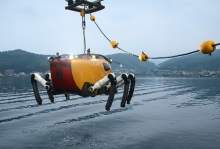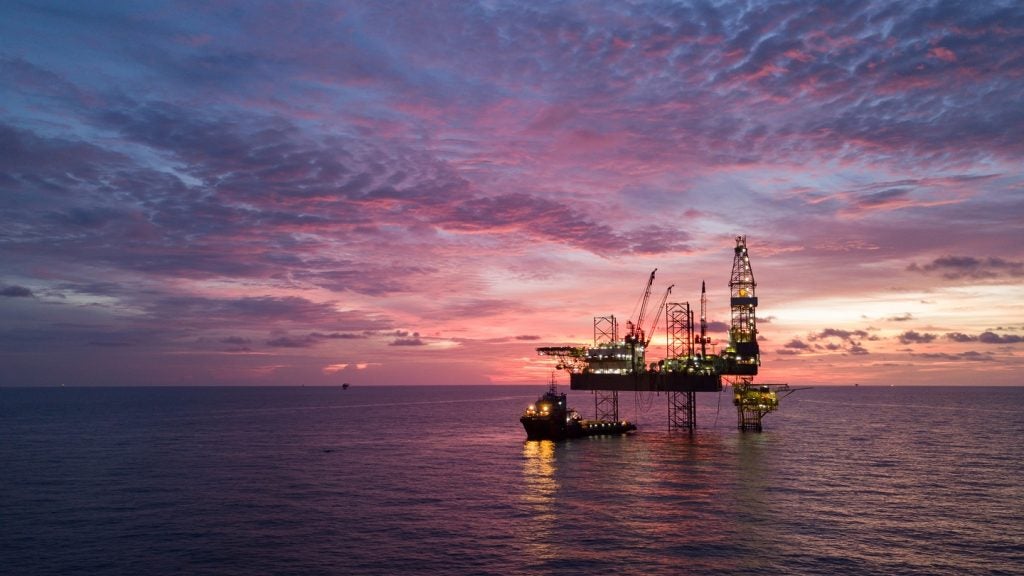
Where it is wetter, a crab is much better. At least that is the position of the Korean Institute of Ocean Science and Technology (KIOST). Spurning conventional seabed exploration machinery, such as propeller-driven remotely-operated vehicles (ROVs) and autonomous underwater vehicles (AUVs), the Institute turned to a crustacean for inspiration.
The Crabster CR200 seabed exploration technology offers researchers and industry carrying out subsea operations an alternative solution to propeller based explorers. For the offshore industry, it offers the potential to make inspections of oil rigs more efficient and minimise the risk of accidents or damage to infrastructure.
The machine, which has been under development for a number of years, is a six-legged crab-like robot that can explore the seabed in a less disruptive and more stable manner than current technologies. The driving logic of the Crabster is that like its real-life counterparts, it will be well suited to contend with stormy conditions. Unlike ROVs and AUVs, which are unstable in strong tidal environments, the Crabster remains able to control its movements under great forces.
How well do you really know your competitors?
Access the most comprehensive Company Profiles on the market, powered by GlobalData. Save hours of research. Gain competitive edge.

Thank you!
Your download email will arrive shortly
Not ready to buy yet? Download a free sample
We are confident about the unique quality of our Company Profiles. However, we want you to make the most beneficial decision for your business, so we offer a free sample that you can download by submitting the below form
By GlobalDataThe six-legged metal crustacean, which is 2.4 metres long, 2.4 metres wide and up to 1.8 metres tall, draws its power and agility from 30 separate motors that enable it to alter its posture to fit with the undersea conditions it encounters. Combining research from a number of Korean academic institutions, the gait algorithm was developed by the Seoul National University of Science and Technology and the swimming motion was developed at the Chunghqam National University, the Crabster mimics both the structure and movements of deep sea crabs.
See Also:
Deep sea explorer
Lowered onto the seabed by crane and capable of operating 200 metres below the surface, the Crabster is controlled remotely by a pilot. Through its sonar scanners it is able to search for objects and artefacts, photograph them with onboard cameras, and relay them to its control centre. Other features installed on the machine include a USBL transponder, an acoustic Doppler, a 6-axis forward leg and a tool sled.
Training offshore divers and ROV pilots using a leading-edge ROV vessel converted from a car ferry, The Underwater Centre is one of the world’s pre-eminent facilities.
Above the surface, a team of four man the controls. The pilot controls its walking and posture, while the co-pilot is responsible for controlling the manipulators, lights, cameras, and other features. The team also includes a navigator to keep track of its position and plan its route, and a sonar engineer who monitors what it sees and registers.
Drawing its power through a tether to an external source above sea level, the Crabster is capable of roaming the seabed for multiple days. The prime conditions it is intended to operate under are when currents are moving at 1.5 metres per second or more, which are dangerous for human divers to work under.
In an interview with CNN earlier this year, lead researcher on the project, Bong Juan Jun, explained that test so far had gone "very well" but that the team were continuing to improve both the software and hardware. He said: "We are performing tests nearly every day. We upgrade Crabster software for more stable and fast walking and manipulation."
Industrially evolved sea life
The main areas that the team are focusing on improving include increasing the speed at which the machine can travel along the seabed, it currently tops out at just 10cm/second, sharpening and the onboard underwater vision system and making further improvements to its stability.
An obvious, yet continuous challenge to the development of the Crabster, is ensuring that the circuitry and electrics embedded within the shell are safely sealed from the water and pressure that surrounds it. "There are many mechanical and electrical parts inside the legs, such as the electrical motors, reduction gears, amplifiers, and interface boards. If even one sealing is faulty, seawater will enter the container which could cause shorts and corrosion. Any single minor problem would require a long time to fix."
Jun went on to explain that he foresees the technology appealing to a broad spectrum of potential buyers: "We suppose CR200 can conduct seabed mapping, survey and inspection of wrecks, pipelines, ecosystems and pollution down to a 200 metre depth. CR200 will help divers or work instead of them in harsh environments. It also could assist in locating underwater resources, carrying out underwater mining, and responding to oil spill incidents."
Further down the line, the team envisage a broad portfolio of machines that draw inspiration from real life sea dwellers. "We are now studying to make the Crabster to swim like turtles or diving beetles. And we are also considering the hydraulic Crabster for heavy-duty underwater working."
The Crabster looks set to be the first robotic sea creature to evolve through industrial demand, but in the not too distant future, thanks to KIOST and no doubt a number of other firms that will start developing alternatives, the sea may well be populated by a host of mechanical subsea creatures.


.gif)



